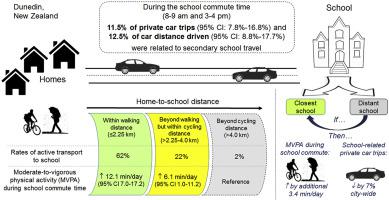Journal of Transport & Health ( IF 3.613 ) Pub Date : 2020-07-17 , DOI: 10.1016/j.jth.2020.100900 Michael Keall , Debbie Hopkins , Kirsten Coppell , Susan Sandretto , Enrique Garcia Bengoechea , John Spence , Gordon Wilson , Sandra Mandic

|
Background
Home-to-school distances and the need for students to be driven to/from school may limit adolescents' physical activity levels. School choice and school zoning policies can influence rates of active transport to/from school, and traffic volumes during school commuting times. This study aimed to quantify the effects of adolescents' enrolment in the closest school or not, on private vehicle use and adolescents’ physical activity levels in Dunedin city, New Zealand.
Methods
New Zealand Travel Survey data (2003–2013; 2493 Dunedin respondents) were analysed to examine school-travel related private motorised trips. Dunedin-specific data from adolescents (from six Dunedin non-integrated public schools without school zoning) were analysed including self-reported survey data on school travel modes (797 adolescents), distance to the current and closest schools (797 adolescents) and accelerometer-measured moderate-to-vigorous intensity physical activity (MVPA) (121 adolescents).
Results
During the school commute time (8–9 am and 3–4 pm), an estimated 11.5% of car trips (95% CI 7.8%–16.8%) and 12.5% of car distance driven (95% CI 8.8%–17.7%) were related to secondary-school travel with approximately half of these involving trip-chaining. Compared to adolescents living beyond cycling distance (>4 km) from their current school, adolescents living within walkable distance (≤2.25 km) and cyclable distance (>2.25-≤4 km) accumulated an additional 12.1 min (95% CI 7.0 to 17.2) and 6.1 min (95%CI 1.0 to 11.2) of daily MVPA during the school commute time, respectively. If adolescents currently enrolled at a distant school were to attend the closest school, they could accrue an additional 3.4 min MVPA during the 2-h school commute time period and school travel-related private car trips would be reduced by 7%.
Conclusions
In Dunedin, New Zealand, modest reductions in private vehicle traffic, particularly around schools, and increases in adolescents’ MVPA during the school commute period would be expected if all adolescents attended the closest school.
中文翻译:

在新西兰达尼丁上最近的学校对青少年的体育锻炼和汽车旅行的影响
背景
家庭到学校的距离以及学生开车去学校的需求可能会限制青少年的体育锻炼水平。学校的选择和学校分区政策可能会影响往返学校的主动运输率以及通勤期间的交通量。这项研究旨在量化是否在最近的学校入学,对新西兰达尼丁市的私家车使用和青少年的体育锻炼水平产生影响。
方法
对新西兰旅行调查数据(2003-2013年; 2493位但尼丁受访者)进行了分析,以研究与学校旅行有关的私人机动旅行。分析了青少年的达尼丁特定数据(来自六所达尼丁非整合式公立学校,没有学校分区),包括关于学校出行方式(797名青少年),到当前和最近的学校的距离(797名青少年)和加速度计的自我报告的调查数据。测量了中度至剧烈强度的体育活动(MVPA)(121名青少年)。
结果
在学校上下班时间(上午8–9和下午3–4下午),估计有11.5%的汽车旅行(95%CI为7.8%–16.8%)和12.5%的汽车行驶距离(95%CI为8.8%–17.7%) )与中学旅行有关,其中大约一半涉及旅行链。与居住在距当前学校骑车距离(> 4 km)以上的青少年相比,居住在步行距离(≤2.25km)和可骑自行车距离(>2.25-≤4km)之内的青少年多积聚了12.1分钟(95%CI 7.0至17.2)上下班期间的每日MVPA)和6.1分钟(95%CI 1.0到11.2)。如果当前在远方学校就读的青少年要就读于最近的学校,则他们在2小时的通勤时间段内可以增加3.4分钟的MVPA,与学校旅行相关的私家车旅行将减少7%。
结论
在新西兰但尼丁,如果所有青少年都在最近的学校上学,那么在学校上下班期间,私家车流量,尤其是学校周围的私家车流量,将适度减少,青少年的MVPA将会增加。



























 京公网安备 11010802027423号
京公网安备 11010802027423号